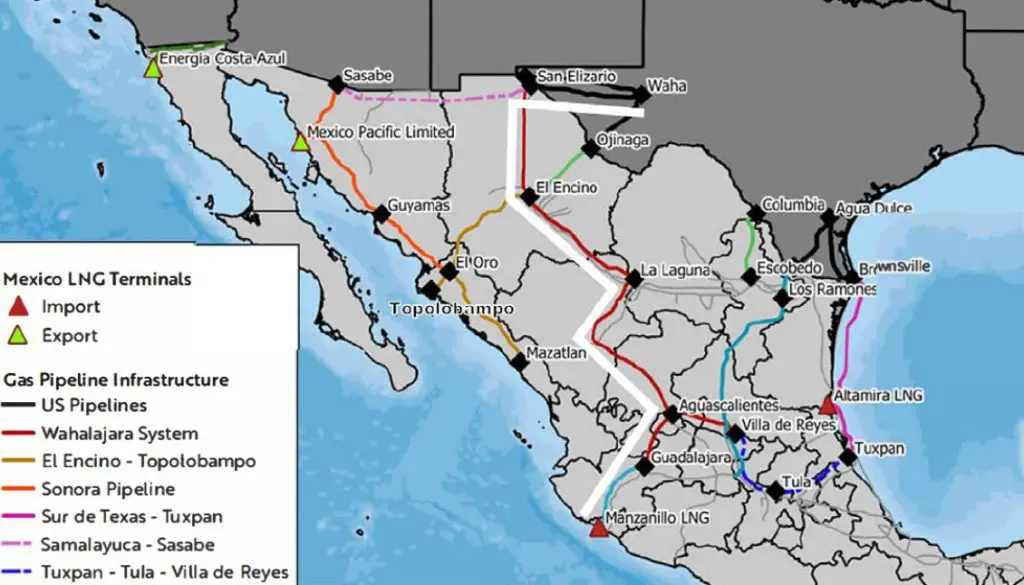Gato Negro Permitium Uno is seeking long-term authorization from the US Department of Energy to export US natural gas via pipeline to its planned liquefaction plant in Manzanillo, Mexico.
According to a filling with the DOE dated May 10, Gato Negro requests authorization to export via pipeline initially to Mexico up to 0.647 billion cubic feet (Bcf) per day of natural gas, and ultimately reexport for delivery to any country that has signed a free trade agreement with the US up to 0.556 Bcf/d of liquefied natural gas (LNG).
Gato Negro requests this authorization for a 20-year term starting on September 1, 2027.
Houston-based Big River Energy, an affiliate of Gato Negro, was granted authority by DOE in December 2022 to export natural gas to Mexico for a two-year term by pipeline.
Big River has also applied for authority to export LNG to Mexico by truck through 2030.
Gato Negro is based in Mexico and is 50/50 owned by Carlos Camacho and Emilio Fuentes, both of whom are citizens of Mexico, the filling shows.
Construction only in Mexico
Gato Negro said it plans to enter into one or more supply agreements of various durations with natural gas producers and marketers in the Permian Basin and potentially other production areas in Texas.
The firm said it expects to sign contractual obligations associated with sales of gas involved in the project as of September 1, 2024.
Hence, Gato Negro requests that DOE/FECM issue an order no later than September 1, 2024.

The project does not involve construction in the US.
Given the location of the project in Mexico, the facility will not be subject to the review of the US FERC under the NGA or NEPA, it said.
Instead, the project and any pipeline facilities that may be constructed in Mexico are subject to review and approval by Mexican agencies under the state and federal laws of that nation.
According to Gato Negro, the firm began the Mexican permitting process in June 2022.
Over one hundred permits, licenses or authorizations in Mexico are required, including archaeological, construction, water, commercial and transportation, and environmental, it said.
Manzanillo LNG plant
Once in Mexico, the natural gas volumes may be liquefied in the Gato Negro Manzanillo LNG plant under development in the state of Colima, Gato Negro said.
Once liquefied, the volumes could be exported to other FTA countries.
The major components that will be constructed as part of the project include up to four liquefaction trains capable of producing up to about 4 mmta of LNG, a gas pretreatment unit for removal of Mercury, acid gas, water, and natural gas liquids, and a jetty.
Other components include emergency vapor management equipment, piping and other facilities to permit the interconnection of the project to existing pipeline infrastructure, and associated utilities interconnections.
Feed gas for the project will be supplied through the TC Energy Guadalajara Manzanillo pipeline.
Gato Negro said the project will use a modular structure employing a refrigerant technology process.
Besides loading LNG to vessels, the Manzanillo Plant will include a truck rack in case some proportion of the natural gas volumes would be resold and consumed in Mexico.
The Manzanillo plant’s location will “benefit” signatories to free trade agreements with the
US, including not only Mexico but Columbia, Korea, Singapore, Chile, and Costa
Rica because the LNG from Manzanillo will not need to transit the potential bottleneck of the
Panama Canal that other LNG supplies from the US Gulf Coast may experience when headed
into the Pacific, Gato Negro said.
The Manzanillo location also will “reduce consumption of maritime fuel for ships transporting LNG to countries located on the Pacific Ocean relative to those cargoes that might serve the same markets that are transported from the US Gulf Coast,” it said.

